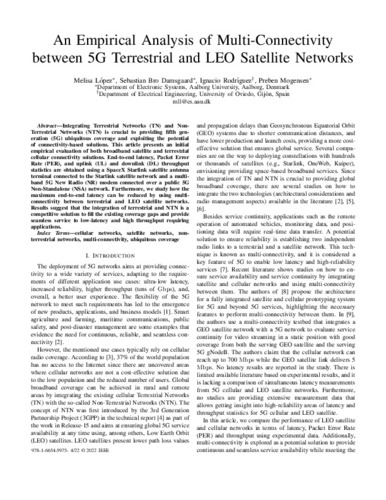An Empirical Analysis of Multi-Connectivity between 5G Terrestrial and LEO Satellite Networks
Autor(es) y otros:
Palabra(s) clave:
Cellular Networks
Satellite Networks
Non-Terrestrial Networks
Terrestrial Networks
5G
Starlink
Multi-Connectivity
Ubiquitous Coverage
Fecha de publicación:
Versión del editor:
Descripción física:
Resumen:
Integrating Terrestrial Networks (TN) and Non-Terrestrial Networks (NTN) is crucial to providing fifth generation (5G) ubiquitous coverage and exploiting the potential of connectivity-based solutions. This article presents an initial empirical evaluation of both broadband satellite and terrestrial cellular connectivity solutions. End-to-end latency, Packet Error Rate (PER), and uplink (UL) and downlink (DL) throughput statistics are obtained using a SpaceX Starlink satellite antenna terminal connected to the Starlink satellite network and a multiband 5G New Radio (NR) modem connected over a public 5G Non-Standalone (NSA) network. Furthermore, we study how the maximum end-to-end latency can be reduced by using multi-connectivity between terrestrial and LEO satellite networks. Results suggest that the integration of terrestrial and NTN is a competitive solution to fill the existing coverage gaps and provide seamless service to low-latency and high throughput requiring applications.
Integrating Terrestrial Networks (TN) and Non-Terrestrial Networks (NTN) is crucial to providing fifth generation (5G) ubiquitous coverage and exploiting the potential of connectivity-based solutions. This article presents an initial empirical evaluation of both broadband satellite and terrestrial cellular connectivity solutions. End-to-end latency, Packet Error Rate (PER), and uplink (UL) and downlink (DL) throughput statistics are obtained using a SpaceX Starlink satellite antenna terminal connected to the Starlink satellite network and a multiband 5G New Radio (NR) modem connected over a public 5G Non-Standalone (NSA) network. Furthermore, we study how the maximum end-to-end latency can be reduced by using multi-connectivity between terrestrial and LEO satellite networks. Results suggest that the integration of terrestrial and NTN is a competitive solution to fill the existing coverage gaps and provide seamless service to low-latency and high throughput requiring applications.
Descripción:
IEEE GLOBECOM Workshops (GC Wkshps) (2022. Rio deJaneiro, Brazil)
ISBN:
Patrocinado por:
This research has received funding from the European Union’s Horizon Europe Research and Innovation Programme, and is conducted as part of the HE COMMECT project, with grant agreement No. 101060881. This work was also partially supported by the Spanish Ministry of Science and Innovation under Ramon y Cajal Fellowship number RYC-2020-030676-I.
Colecciones
Ficheros en el ítem

Métricas
Compartir
Estadísticas de uso
Metadatos
Ítems relacionados
Mostrando ítems relacionados por Título, autor o materia.



